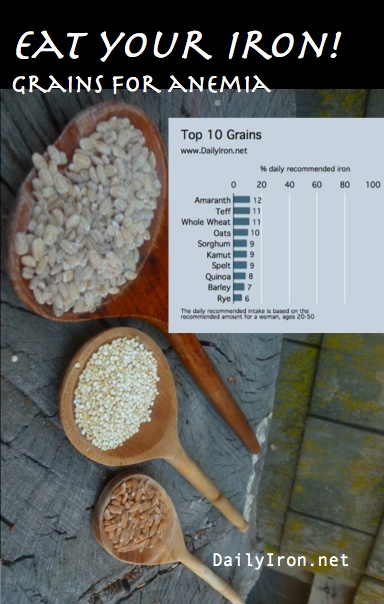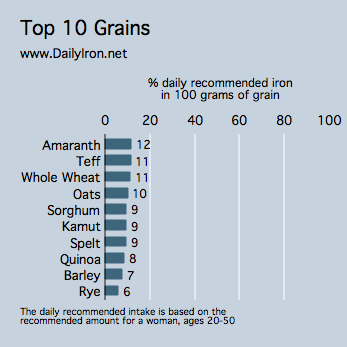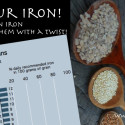 Grains are an important source of iron in a plant-based diet. The bran of the grain is high in iron as you may note from our Top Ten list at right based on data from the USDA. However, teff, amaranth, and oats are high as well. Quinoa, a grain rising in popularity in the United States, just missed the list of the Top Ten.
Grains are an important source of iron in a plant-based diet. The bran of the grain is high in iron as you may note from our Top Ten list at right based on data from the USDA. However, teff, amaranth, and oats are high as well. Quinoa, a grain rising in popularity in the United States, just missed the list of the Top Ten.
If you are relying on grains for your iron, it is important to note that grains include potent iron inhibitors that will keep you from absorbing much of the iron in the grain itself. In fact, the inhibitors in the grains may affect your absorption of iron in the vegetables you are eating with the grains.
The most potent inhibitor of iron in grain is a substance called phytic acid. Phytic acid is found in most abundance in grains, legumes, nuts, and seeds and could be directly contributing to your iron deficiency. However, phytic acid is easily reduced with strategic kitchen preparation techniques. Here are three examples:
- Quinoa can be soaked overnight in warm water and then rinsed before cooking. The soaking will reduce the cooking time and also reduce the phytic acid, essentially “unlocking” more of the iron in the quinoa itself.
- Rolled oats, too, can be soaked overnight. When you cook them in the morning as a breakfast cereal, they will cook up as quickly as do quick oats. In the Iron Rich Foods book we recommend adding some fresh ground wheat or rye to the oats before soaking because oats lack a native enzyme to reduce phytic acid.
- Banana bread can be made with whole wheat flour using a very simple sourdough technique. The whole grain provides an abundance of iron and the sourdough breaks down the phytic acid. We include a very simple “cheater’s” sourdough process in the Iron Rich Foods book for beginning bakers.
 Generally speaking, any “whole grain,” that has not been processed nor had the bran removed (as is the case with “white flour” products), will be fairly high in iron and will provide an opportunity for you to increase the iron content of your diet should you soak the grain or ferment it to reduce the phytic acid content. These are iron rich grains.
Generally speaking, any “whole grain,” that has not been processed nor had the bran removed (as is the case with “white flour” products), will be fairly high in iron and will provide an opportunity for you to increase the iron content of your diet should you soak the grain or ferment it to reduce the phytic acid content. These are iron rich grains.
Iron Content Of Common Grains And Pasta
To explore some of the more popular whole grains, check out the links below for graphic representations of their iron content.
Explore the many other resources of the iron rich foods website.
